This is a guest post from Rob Walling, co-founder of Drip, an email marketing and automation tool. We use Drip for email marketing at Bidsketch, and this guide will give you some great ideas on how to use drip email marketing to work smarter, not harder, when it comes to growing your consulting business.
OK, so an honest question…
Why did you really want to become a consultant?
The Freelancers Union estimates that there are 53 million freelancers in the US (around 34% of the total workforce). In their research, they’ve found that the two biggest drivers of freelancing are 1) earning more money and 2) schedule flexibility.
When business is good, no doubt, it’s really good. You set your own schedule. When the weather is nice, you take off at 2PM for a walk in the park. You have no boss, and the sky’s the limit for how much money you can make.
However, consulting has its downsides…
In another recent study, 60% of business owners that “weren’t planning on taking any vacation in the next 12” months cited financial hardship. Inevitably, there are months when finding clients is a grind. Couple that with unpaid work like invoicing and accounting, and it can feel like you’re burning the candle at both ends.
But it doesn’t have to be that way.
In this guide, we’ll look at one strategy you can use to save time, attract higher quality clients, charge higher rates, and even plan for a guilt-free vacation or two.
The strategy I’m talking about is drip email marketing. When you set this up, you’ll have qualified leads coming to you, so you have more consistent deal flow and more options.
Here’s the overall process:
- Publish Content (Before You’re Ready)
- Write An Educational Email Mini Course
- Create Your Irresistible Low-End Offer
- Wire Up Your Online Scheduling Software
- Scale Your Pipeline and Nurture Existing Clients
Ready?
Let’s dive in.
Step #1: Publish Content (Before You’re Ready)
Have you noticed…
More and more consultants these days are putting out blog posts, podcasts, and guides? There’s a reason why.
It works.
According to WebDAM, B2B companies that blog generate 67% more leads per month than those who do not.
Not sure if this applies to your agency?
Brandon Seymour, an SEO consultant from Beymour Consulting, wrote a single guest post for a major digital marketing industry blog, which led directly to an incredible $85,000 in new client retainers.
“It took me 2.5 hours to write and publish the article. The 6 clients that found me through this article brought in $85k in revenue.”
Not bad for one article.
Of course, most consultants won’t pull in 5-figure consulting clients from a single post.
But the reality is, you’ll need content to create your email marketing machine (more on that below).
And when you write content for an audience that includes your target market, you never know who will read your post. Authoritative content frames you as an expert in your field, and you might find that one blog or publication feeds you leads.
There’s one other thing to keep in mind…
As a consultant, it’s important that you choose a medium of content you’ll actually commit to.
Kai Davis, founder of Double Your Audience, generates the bulk of his lucrative consulting leads not from guest posts—but from podcasts.
“My main marketing channel is podcasts. People hear me on a podcast and then reach out. Typically it’s Podcast → Consulting Website → Contact, not even necessarily coming to me through my list.”

Kai Davis demonstrates expertise to prospects before they ever speak to him.
No articles needed.
The bottom line is that you need to create (content) assets. Whether it’s YouTube, SlideShare, or podcasts, start putting out content where your ideal audience hangs out.
Case studies are perfect. If you don’t have those, simply write some articles on your topic of expertise, and pitch them as guest posts to industry blogs. Again, you’ll need them for your automated email machine.
Key Action Items:
- Choose a medium (blogging, podcasting, video, etc.) in which you excel
- Brainstorm a list of case studies or step-by-step guides that would be useful for your potential clients
- Create a content calendar and stick to it
Next up, we’ll need to turn those website visitors from guest posts into leads, which brings us to…
Step #2: Set Up An Automated Email Mini Course
Here’s a surprising statistic:
According to ConversionMonk, over 70% of website visitors who abandon your website will never return.
The last thing you want is to drive potential clients to your website… only to lose them for good.
Even 100 website visitors from the right guest post or podcast interview could include a dozen potential clients. And email courses are one of the best ways to turn fly-by visitors into prospects and paying clients.
An email mini course typically consist of 5 to 7 lessons, delivered via email, written to help a subscriber solve a specific problem or pain point.
Here’s one example from Growth Everywhere blogger Eric Siu, who grows his email list by giving away an email course on enterprise SEO:

An SEO-focused email crash course from Growth Everywhere.
As another example, Philip Morgan from My Content Sherpa captures leads with a mini course called “Get More Leads With Content Marketing.”
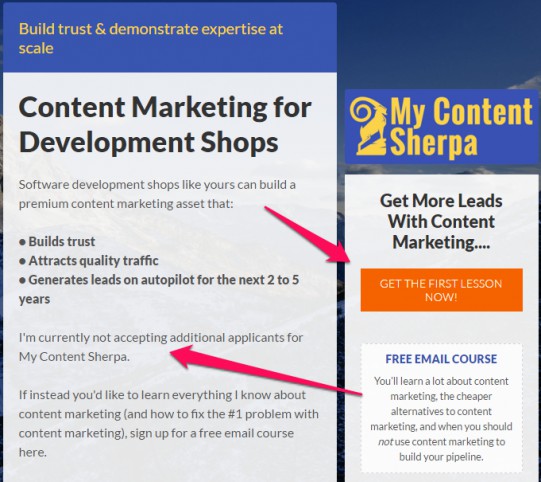
MyContentSherpa’s email crash course.
Notice the line:
“I’m currently not accepting additional applicants for My Content Sherpa.”
Imagine if, instead of leads or prospects, you had “applicants” for your services.
That’s the power of inbound marketing.
When leads subscribe to MCS’s mini course, they receive a series of content-packed lessons via email, automatically. They drip out over time, with lesson #1 sent immediately after sign up, lesson #2 sent the next day, and so on.
Before prospects ever speak to Morgan, they’re already warmed up and sold on Morgan’s expertise.

Phillip Morgan’s marketing system lets him take “applicants” for his consulting retainers.
You can do this, too.
If you’re a graphic designer who helps small businesses, write a mini course called “How To Brand Your Small Business and Attract More Customers” and give it away on your website.
Whatever problem you solve, you’ll want to outline 5 or 7 lessons that warm up prospects.
Here are a couple tips to keep in mind:
- Social proof sells. As highly sought PR consultant Ryan Holiday writes, “people love case studies.” Give your email lessons plenty of stories and crunchy examples of how you’ve helped clients.
- Take it easy on the pitch. Effective mini courses should focus on teaching, not pitching. In our email templates, you’ll notice that we recommend one soft sell per email (at the bottom). That’s enough. Don’t overdo it.
As prospects enter your mini course, you’ll be building an asset.
Some folks won’t be ready to buy now—but they’ll need your services next month or in six months.
An email list is also one of the best tools to hedge against “down” months in your business. If you’re squeezed for cash, you’ll have a list of prospects who know, like, and trust you. And with the right offer, you just might be able to make $10K in 72 hours with a single email.
Key Action Items:
- Click here to download our fill-in-the-blank email templates, or write your own email course from scratch
- Queue up your emails in your preferred marketing automation tool
- Add a widget or lightbox to your website to start collecting email addresses with your mini course
Step #3: Create Your Irresistible Low End Offer
You’re creating content.
You’re driving prospects to your website.
You’re warming up leads with an automated email mini course.
Now it’s time to bring in the money.
Most consultants opt to push for a free consult and go straight to a high-ticket proposal, but it’s sometimes easier to charge $10,000 after you’ve worked with a client and they already trust you.
That’s why Brennan Dunn from Double Your Freelancing recommends you sell Roadmapping—one-off, low risk strategy sessions that let you and a client get to know each other. Then, you upsell the client into your core offer.
To illustrate, let’s look at a case study.
On Digital Marketer, Ryan Deiss tells the story of a Google AdWords and SEO agency that added $21,300 per month in recurring revenue from a single trade show. The agency rented a booth at a trade show for locksmiths, something they’d been doing previously for years with so-so results.
The secret sauce with this event, as Deiss writes, was that the agency stopped pushing their $500/mo service, and instead advertised an irresistible low end $20 offer.
In this case, the agency charged locksmiths just $20 to create their Google My Business listing and set up their Google AdWords account according to best practices.
After 87 locksmiths purchased their “no brainer” $20 offer, after upsells and following up, the agency converted a whopping 42 new clients at $500/mo for their core offer (managed SEO and PPC services), for a total of $21,300/mo in recurring revenue.
Here’s the best part:
You can automate nearly all of this in your email funnel.
Let’s say you’re a freelance WordPress developer for tech startups. Simply wrap up your email mini course about web development with an offer for a $300 Website Opportunities X-Ray. This is your low-end offer.
You might review a client’s website, prepare a report with your suggestions, and personally walk them through the report on a 60-minute Skype call for $300.
Here’s why this works so well:
Without risking thousands on an unproven consultant, your client can get to know you, and will be much closer to investing in your flagship $7,000 package.
Let’s look at yet another case study to see how successful consultants are selling low-end offers via email… without lifting a finger.
4. Wire Up Your Online Scheduling Software
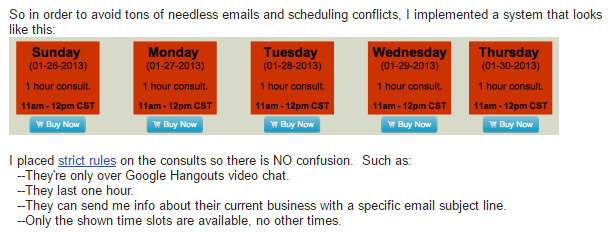
Neville Medhora sells 1-on-1 video consults like digital products: sold via email and purchased upfront.
In the image above, you can see how copywriter Neville Medhora from Nevblog structures his consultations.
First, Medhora chooses times he’s available. Next—to minimize scheduling back-and-forth—he adds a Buy Now button for open slots on his calendar. Finally, he sends an email blast to his list with a “first come, first served” offer.
That’s it. But before we get into configuring this, a quick warning:
You need to build an email list for this to work.
If you haven’t implemented steps 1 through 3 above, make sure you do so. That’ll give you an audience that gives you permission to market to them.
How you structure your low-end offer really depends on your sales process.
To keep things simple, create a free account at TimeTrade or Calendly, and sync up with your online calendar, like Google Calendar.
These tools will let you create your own appointment setting page, so your prospects can easily schedule pre-set times when you’re free.
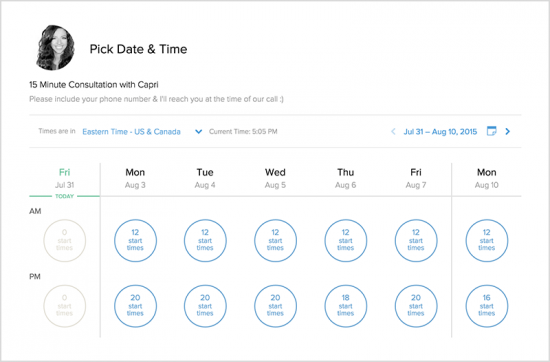
Integrate your calendar with Calendly for frictionless call scheduling. Image: Calendly.com
You can make “schedule a consultation” your Call To Action in the P.S. of every email.
Neil Patel, who’s landed million dollar consulting deals with Fortune 500 companies like Google, Facebook, GM, and NBC, includes a P.S. in every single email, directing folks to his consulting inquiries page.
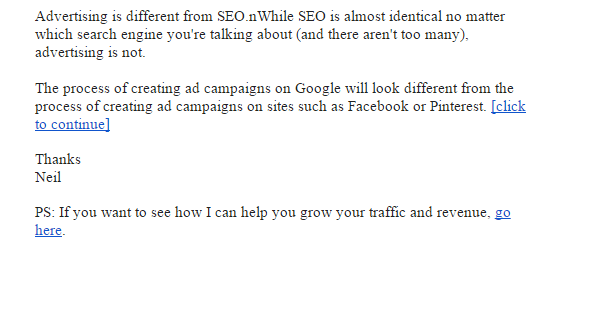
Notice Neil Patel’s typical P.S. at the bottom.
When you add this “soft sell” PS to your educational mini course, you’ll book consultations while you sleep.
And if you use an irresistible low-end offer like I’ve recommended, you can even sell paid one-hour consultations to clients, without doing anything or writing a single email.
And that’s the goal, right?
In many cases, setting up this system alone can give you more freedom and create a breakthrough in your consulting business.
But in case you want to grow even faster, we’re going to take it one step further…
5. Scale Your Pipeline and Nurture Existing Clients
Once your machine is in place, you’ve done the bulk of the work.
The final step is scaling up your pipeline and adding even more subscribers into your funnel. How you do this is up to you.
You can continue to focus on content marketing. Or you can look at other traffic sources like Facebook ads, SEO, and co-promotion with non-competitive agencies that share your target market.
For the purposes of this post, I’ll highlight one particular lead source that’s underutilized by most agencies.
Speaking gigs.
In Three Actionable Tactics That Can Help You Make Six Figures As A Freelancer, consultant Ross Simmonds writes:
“Public speaking is a super power in the world of freelancing. Why? Because it’s a tactic that works.”
If you can speak in front of your target audience, you’re automatically perceived as an expert. And with a few case studies, you’ll convince attendees that you can get results.
To get leads into your funnel, add a URL on the final slide of your presentation with a Call To Action to get your free mini course. You’ll still get all the business cards and handshakes you’d normally get from a speaking gig, but you’ll also continue the conversation with attendees who aren’t quite ready—but want to learn more from your content.
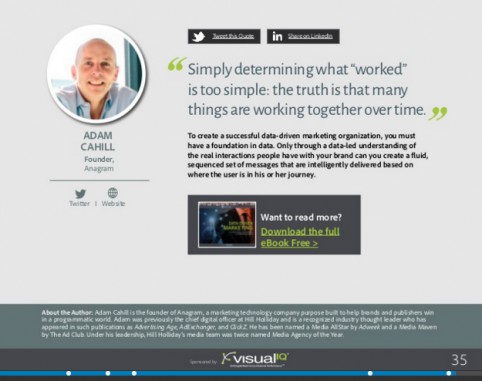
Pro Tip: utilize your final slide. (Source: “Data-Driven Marketing” via SlideShare)
You can also tap into your existing client base for leads.
According to the authors of Marketing Metrics, you have a 60 to 70% chance of selling to an existing customer, while the probability of selling to a new prospect is only 5% to 20%.
That’s why it makes sense to stay “top of mind” with not just new leads, but also your old clients. You never know who might have a new project or referral for you.
To keep your time commitment low, it’s better to curate content for your old clients. You can create a client nurture campaign in less than 60 minutes per month.
Here’s how to do it:
- Use a tool like Diigo to bookmark links to interesting content you find throughout the month on your topic of expertise.
- Once a month, copy and paste those links you’ve saved into one roundup-style email, adding a few sentences of commentary underneath each link.
- Send the email to every contact that’s tagged ‘Client’ or ‘Friend’ in your email marketing tool. Watch the friendly replies and connections come in.
Here’s how Justin Brooke, an online advertising consultant, uses this approach to send his weekly newsletter.
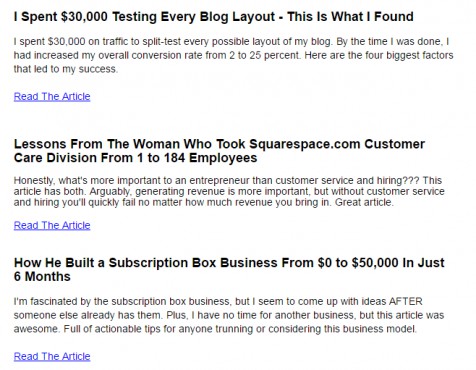
A classic “curated content” email newsletter.
Each week, Justin Brooke curates the best marketing content from around the web.
Simple, right?
If this seems like a lot of work, you can use the Rev Voice Recorder iOS app to speak into your smartphone, and pay $1 per minute to get the audio transcribed to text.
As Seth Godin writes, even if you struggle with writing, “no one ever gets talker’s block.”
The point here isn’t to add another item to your to-do list.
The point is to take advantage of automation and the power you can create in numbers. When you send emails to hundreds, thousands, or even tens of thousands of potential leads, you’re bound to get clients. Make it work for you, and watch your internal hourly rate skyrocket.
Conclusion
Prospecting for work can be a huge time suck. But it doesn’t have to be that way.
When you build an automated email marketing machine, you can shave hours off your workweek, take back your freedom, and choose which clients are appealing to you.
It’s possible to wake up in the morning, check your inbox, and have potential clients engaging you. You just need to take the right steps.
- Publish Authority Content
- Write An Educational Email Mini Course
- Create Your Irresistible Low-End Offer
- Wire Up Your Online Scheduling Software
- Scale Up and Nurture Existing Clients
To give you a head start, we’ve put together fill-in-the-blank email templates, written just for consultants. Click below to get it.
Exclusive Bonus for Bidsketch Readers: Click here to get your free fill-in-the-blank crash course templates for consultants.

